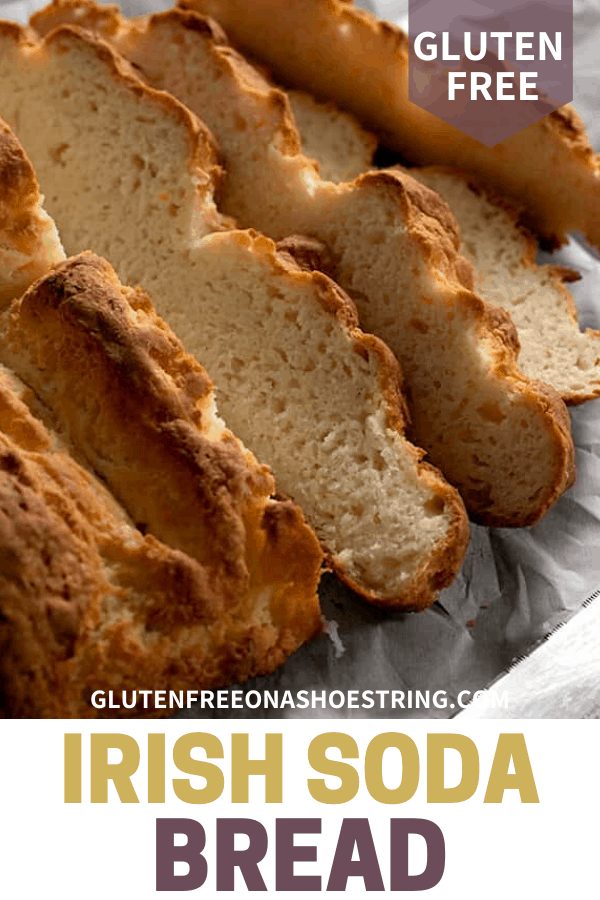

The simplest, most classic savory gluten free Irish soda bread, made with flour, baking soda, buttermilk, and just a touch of cold butter.

Why this savory gluten free Irish soda bread recipe is so special
I first developed my original recipe for gluten free Irish soda bread when my gluten free son was in grammar school, so he wouldn't feel left out during those celebrate-every-holiday-with-food years.
The older he gets, of course, the more powerless I've become in that way (all ways?). If I think too hard about that, I'll need a bonus therapy session this week ? so let's move on…
All 3 of my children love even the very idea of Irish soda bread, since it's, well, sort of like a big old biscuit, no matter which way you make it. This version is quite different than the first, though, as it's a savory gluten free Irish soda bread.
I serve it for breakfast, for an after school snack, and as a dinner side. It can even be used for a sandwich, if you can believe that, since it's delightfully soft but chewy inside and crusty inside.

Only the simplest ingredients in this savory Irish soda bread
The most traditional Irish soda bread, as I understand it having admittedly not a drop of Irish ? blood to be sure, is a simple quick bread recipe, made with flour, baking soda, salt, and buttermilk.
Perhaps because we Americans can't resist, we've added sugar, butter, and made it into more of a sweet treat, like in my original soda bread recipe. This recipe is little more than the most traditional flour, baking soda, salt, buttermilk formula. The two tablespoons of sugar help round out the flavor of the bread, but they're entirely optional.
For a bit of richness and additional moisture, I've added a few tablespoons of unsalted butter. Since it's such a simple recipe, you must use all of the ingredients if you want a beautiful loaf that's crisp on the outside, soft and chewy inside.
For a more highly enriched, sweetened bread with raisins or currants, I recommend my original recipe for gluten free Irish soda bread.

Tips for making a great savory gluten free Irish soda bread
Buttermilk is not just milk with vinegar or lemon
You'll find heaps of information on the Internet from all sorts of reputable websites claiming that buttermilk can be replaced in any recipe that calls for it with a “soured” milk of one kind or another. Please … don't do that?
Souring milk with a tablespoon or so of lemon juice, cream of tartar, or white vinegar will make your milk taste a bit sour, and may even form a few curdles if it's cow's milk. But it will not replicate the thickness and taste of modern, store-bought buttermilk.
Originally, buttermilk was the liquid left over when butter was churned from cream. Modern buttermilk, however, is cultured which results in a more distinct taste and thickness. It's thinner than plain yogurt, but similar in taste.
That's why my favorite substitute for store-bought buttermilk is a mixture of half milk, half plain yogurt (the thinner, European-style of yogurt works best). I do tend to use that mixture interchangeably in recipes with buttermilk, and truly have no issue.
Keep your soda bread ingredients cold
There are only 3 tablespoons unsalted butter in this incredibly simple recipe, but they and the buttermilk must be kept cold. Since there's no yeast in this gf bread recipe, the cold fat helps give the bread lift in the oven.
Let your baked gf bread cool before you slice it
Like any freshly baked bread, it's tempting to slice right into it while it's still hot from the oven. But resist the urge! Let the loaf cool to at least warm room temperature before you slice it, and you don't have to worry that the bottom will compress and become sticky.

Ingredients and substitutions for savory gf Irish soda bread
Dairy free savory Irish soda bread
There is dairy in both the butter and the buttermilk in this recipe. In place of the cold, grated butter, try using Melt brand or Miyoko's Kitchen brand vegan butter (my favorite butter replacements for most purposes).
If you can't find either brand of vegan butter, you can try using Earth Balance buttery sticks, but use 2 tablespoons instead of 3. I also think that Spectrum brand nonhydrogenated vegetable shortening (preferably butter flavor) would work great, but even the whisper of shortening seems to send some into a tailspin. In that case, forget I said anything. ?
In place of buttermilk, try using half plain nondairy yogurt and half nondairy milk. Please scroll up for a more complete discussion of replacing buttermilk in recipes. TL;DR version: do not use milk “soured” with some acid.
Cream of tartar
If you can't find cream of tartar, you can leave this ingredient out but I prefer the results when I add it. It's an acidic agent, which is already present in the buttermilk, but it also helps the bread maintain its rise and white color inside.

How to make savory gluten free Irish soda bread, step by step
Savory Gluten Free Irish Soda Bread | The Simplest GF Bread
Ingredients
- 3 cups (420 g) all purpose gluten free flour blend (I used Better Batter)
- 1 ½ teaspoons xanthan gum omit if your blend already contains it
- 2 teaspoons baking powder
- 1 teaspoon baking soda
- ½ teaspoon kosher salt
- ¼ teaspoon cream of tartar
- 2 tablespoons (25 g) granulated sugar (optional)
- 3 tablespoons (42 g) unsalted butter grated and chilled
- 2 ½ cups (20 fluid ounces) buttermilk chilled
Instructions
- Preheat your oven to 375°F. Line a 10-inch cast iron skillet with parchment paper and set it aside.
- In a large bowl, place the flour, xanthan gum, baking powder, baking soda, salt, cream of tartar, and optional sugar, and whisk to combine well. Add the grated and chilled butter, and toss to coat the butter in flour and evenly distribute it throughout the dry ingredients.
- Add about half of the buttermilk, and carefully mix to combine. We don’t want to make the dough particularly smooth.
- Add the remaining buttermilk, and mix, folding over with a large spoon or spatula until just combined. The dough will be thick and shaggy, but not stiff.
- Transfer the dough to the parchment paper in the skillet (you can remove the paper from the skillet to shape the dough, and then return it to the skillet for baking). Using a combination of wet hands and/or a moistened silicone spatula, gently shape the dough into a disk about 10-inches in diameter.
- Using a sharp, wet knife, score the loaf by slicing a large “X” on the top, each cut about 2 1/2-inches deep and all the way across the loaf. Move the knife quickly through the loaf so it doesn’t drag the dough with it.
- Place the skillet in the preheated oven and bake for 30 minutes. Increase the oven temperature to 400°F and bake until lightly golden brown all over and firm to the touch in the center, about another 15 minutes.
- Allow the loaf to rest in the skillet for about 10 minutes before lifting it out by the parchment paper and sliding it off the paper onto a wire rack to cool completely.
- Slice by cross-section and serve.
Savory Gluten Free Irish Soda Bread | The Simplest GF Bread
Ingredients
- 3 cups (420 g) all purpose gluten free flour blend (I used Better Batter)
- 1 ½ teaspoons xanthan gum omit if your blend already contains it
- 2 teaspoons baking powder
- 1 teaspoon baking soda
- ½ teaspoon kosher salt
- ¼ teaspoon cream of tartar
- 2 tablespoons (25 g) granulated sugar (optional)
- 3 tablespoons (42 g) unsalted butter grated and chilled
- 2 ½ cups (20 fluid ounces) buttermilk chilled
Instructions
- Preheat your oven to 375°F. Line a 10-inch cast iron skillet with parchment paper and set it aside.
- In a large bowl, place the flour, xanthan gum, baking powder, baking soda, salt, cream of tartar, and optional sugar, and whisk to combine well. Add the grated and chilled butter, and toss to coat the butter in flour and evenly distribute it throughout the dry ingredients.
- Add about half of the buttermilk, and carefully mix to combine. We don’t want to make the dough particularly smooth.
- Add the remaining buttermilk, and mix, folding over with a large spoon or spatula until just combined. The dough will be thick and shaggy, but not stiff.
- Transfer the dough to the parchment paper in the skillet (you can remove the paper from the skillet to shape the dough, and then return it to the skillet for baking). Using a combination of wet hands and/or a moistened silicone spatula, gently shape the dough into a disk about 10-inches in diameter.
- Using a sharp, wet knife, score the loaf by slicing a large “X” on the top, each cut about 2 1/2-inches deep and all the way across the loaf. Move the knife quickly through the loaf so it doesn’t drag the dough with it.
- Place the skillet in the preheated oven and bake for 30 minutes. Increase the oven temperature to 400°F and bake until lightly golden brown all over and firm to the touch in the center, about another 15 minutes.
- Allow the loaf to rest in the skillet for about 10 minutes before lifting it out by the parchment paper and sliding it off the paper onto a wire rack to cool completely.
- Slice by cross-section and serve.



Thaedra Jayne says
This recipe had to have been the easiest and moat successful quick bread I’ve ever made! Used my own flour blend of millet, tapioca and oat and used the milk/yogurt sub for buttermilk. I did use the sugar and love the savory sweetness. Thanks so much for making the Celiac world a tastier place
Louise says
I made this last week for my newly diagnosed 8 year old coeliac son and he LOVED it! Thank you very much for sharing, it’s cheered him up to have something delicious. I’m in the UK and used Dove Farm Freee plain white flour., that worked just fine I didn’t have cream of tartar in the cupboard but have got hold of some now (as someone else said it’s widely available here) and looking forward to trying it with that today. Also the donuts recipe, which my eagle-eyed son has spotted and requested!
Nicole Hunn says
Hi, Louise, yes I’ve only heard good things about readers in the U.K. using Dove’s Farm plain flour in place of Better Batter in my recipes. I’m so glad for that, and that your son enjoyed the Irish soda bread. I was like you, way back in 2004 when my son was diagnosed, and wanting to give him something delicious eventually led to this whole food blog. So the newly diagnosed celiac son stories always hit me right in the heart. Thank you for sharing yours. ?
Rita Ashe says
Hi Nicole , I am in UK and am using a Juvela flour. It was very wet and couldn’t just put on to skillet, too loose. Could you please give me more advice as you GFsoda bread looks delicious . I have been Coeliac for over 39 years and am still trying to make Irish Soda Bread .
I really would like help with this. Should I send my email address. Thank you in advance . Rita
Nicole Hunn says
I’m not available for an individual consult, Rita, but the issue sounds like it’s with your flour blend. Please click through the link that is associated with the mention of all purpose gluten free flour in the recipe itself. That will explain about all purpose gluten free flour blends.
Nancy Gillespie says
Made this for the first time today. Luckily, cream of tartar. Is widely available in the U.K. It was super easy to make and my coeliac husband loved it – as did I. Chewy on the outside and soft inside. Already planning to try a version with some grated cheddar cheese.
Many thanks for another great recipe!
Ellen says
I made this recipe exactly, using half coconut yogurt and half almond milk for the buttermilk, and it turned out great. My loaf needed every bit of the baking time. It was great with a pot of soup.
Nicole Hunn says
It’s really the best way to replace buttermilk, the half yogurt and half milk formula, and I’m so glad you had success. Sounds very cozy with soup, Ellen!
Shelley says
I have been having such a hard time with gf bread. The store bought stuff is either incredibly sub-par, or ridiculously expensive. And me and yeast just don’t seem to work well together. My usual solution is to just eat nothing. At all. ? This might just be my new go-to, easy bread to satisfy my bread (and peanut butter toast ) needs!! It just came out of the oven and the first slice was delicious! Question – can I freeze it (or half of it)?
Nicole Hunn says
You can definitely freeze it, Shelley. It’s quite moist, though, so you’re best off cooling it completely, slicing it, and placing a small piece of waxed paper in between slices so they don’t fuse together completely during freezing. Then, place in a tightly sealed freezer-safe wrap, and freeze.
Young Paciello says
Hi there. Although I am not a celiac intolerant person, I have been dealing with breast cancer for the last 7 years. It keeps mutating and I have to go on new protocols. C’est la vie. Anyway, as sugar feeds cancer and gluten turns to sugar, I have been slowly replacing pasta and breads and cookies with gf alternatives and your recipes, consistently, are the best ones. Thank you so much for your “ministry” to the food world!
Nicole Hunn says
Thank you so much for the kind words, Young, and I wish you good health. ?
Jane says
I am lactose intolerant. I wonder if you could substitute a Keifer for the buttermilk…it is like a runny yoghurt?
Nicole Hunn says
Kefir contains lactose, Jane, unless you are somehow using a lactose-free version. Otherwise please see the Ingredients and substitutions section for all the information I can provide on that.
Bernadette says
Can this be made in a non-iron pan, like a non stick cake pan with success?
Nicole Hunn says
Yes, Bernadette, you can make it in a round, nonstick (or lined) cake pan. The heavier gauge the better.
Mark Linton says
Hi Nicole
I usually bake in silicone baking pans. Is this going to be a big mistake, or a mildly tolerable one? How high does the bread rise?
Thanks – love your recipes
Mark Linton
Israel
Nicole Hunn says
I do not recommend baking in silicone, Mark, as it tends to discourage rising. It’s especially unwise for a recipe like this that is designed to be made in a heavy metal pan.
Anna says
This was so good! Even my husband loved it. We had it for supper—something we never do!
Nicole Hunn says
Great to hear, Anna! It’s great for a dinner side, and actually keeps really well for a second night if wrapped tightly and stored at room temperature.
Tina says
20 fluid oz seems a lot! I made it with 500 ml / 2 cups of Buttermilk but it still turned out quite moist and soggy… Putting it together seemed more like making a mud cake ; )
Nicole Hunn says
Tina, the recipe works when made as written. Please have a look at any substitutions that you made, including your flour blend (you must use one of my recommended blends), and measuring by volume, not weight.
Sarah Davis says
Hello Nicole. Thank you for the recipe. It’s nice to have a not-sweet quick bread. Can the bread be baked in a different type of pan? I don’t have any cast iron.
Nicole Hunn says
Sure, Sarah. You can make it in a round, nonstick (or lined) cake pan. The heavier gauge the better.
Deb Thoele says
What brand name of thinner yogurt can be used? I am so excited to be able to try a gf bread that will Finally taste good-I’ve tried so many and they failed miserably. I hope to find one that my husband will like. Anxious to try this one.
Nicole Hunn says
Hi, Deb, you can use half plain yogurt and half milk, not all yogurt. And I’m just referring to the European-style yogurt, not Greek-style or whipped, thicker yogurts.
Columbia Corindia says
Hello….
I was wondering where I could get your cook books, I live in Oshawa, Ontario, Canada.
Nicole Hunn says
Hi, Columbia, you can find my cookbooks anywhere books are sold, including Amazon and Chapters/Indigo. I hope that’s helpful!
Jill says
Hi Nicole, because I am student who only has an electric oven in my dorm room can I make this as muffins and if so how long do I cook them and at what temperature. By the way I’ve loved every one of your recipes I’ve tried.
Nicole Hunn says
I’m afraid you can’t use this recipe to make muffins, no, Jill. I’d try one of my recipes for muffins, as they’re really not interchangeable, especially for this, which is not a regular quick bread.
Janet Lilenfeld says
I can’t wait to try it,I may make one with raisin too.
Do you have a recipe for easter bread? The one with the colored egg in it?I used to make individual loaves for everyone. So pretty on the dinner table.
Nicole Hunn says
Hi, Janet, I’m afraid I don’t have a recipe for Italian Easter bread. They are really beautiful! You could probably use the recipe for challah bread in my bread book, though.
Kathleen rose says
Would it be possible to print your recipe without having to print 10 pages?It starts withGluten Free on a Shoestring and ends 10 pages late! Thanks.
Nicole Hunn says
There is a “print” icon at the top of the page and at the bottom of the recipe. It only prints the recipe, not the blog post, Kathleen. I’m not sure what you mean by “10 pages.”